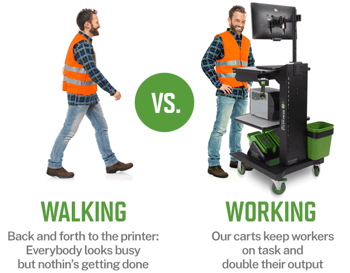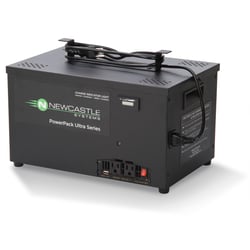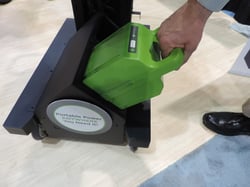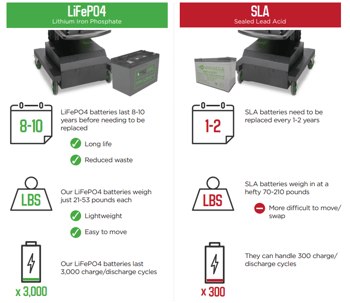
Many of today’s businesses rely on mobile workstation carts as an efficient and cost-effective automation solution to improve productivity. These energy-efficient workstations on wheels streamline operations in warehouses, manufacturing plants, food service operations, and retail stores, where they allow employees to use technology right where they work, improving accuracy and productivity.
But choosing the right mobile power cart is just the first step toward achieving your goals. You also need the proper power source. Here’s what you need to know about the different options for powering your mobile workstation so you can choose the right battery technology for your needs.
What is a Mobile Workstation?
Mobile workstations bring whatever technology you normally use in an office environment onto the floor. They are economical ways to improve production in a variety of workplaces, including warehouses, distribution centers, eCommerce fulfillment, manufacturing facilities, hospitals, third-party logistics, retail stores, and more.
Why Choose a Mobile Workstation?
Having inflexible equipment can be extremely limiting for a business and its employees. One of the biggest advantages mobile workstations offer businesses is flexibility. Here are some of the other reasons organizations are choosing to use these products:

- Productivity — A mobile workstation allows workers to be more productive because their workstation is always right where they need it. As their location changes, they can simply wheel the station along with them.
- Safety — Mobile workstations use mobile power, so they are convenient and safe. They also cut down on employee fatigue, which can lead to errors and accidents.
- Morale — No employee wants to work in a tedious and inefficient environment where they’re forced to walk back and forth between two areas repeatedly. A mobile workstation reduces these pointless trips and improves morale.
- Cost — Sure, there’s an upfront cost for the equipment. But, you’ll also want to consider the long-term savings you’ll enjoy by using mobile workstations. This includes lower overhead costs for unnecessary office space and lower labor costs due to improved efficiency.
Powering Your Mobile Workstation
With advances in battery technology, you now have several possible ways to power your mobile workstation. Many of today’s mobile workstations use swappable power systems. But some, for a variety of reasons, rely on fixed power systems.
Swappable Power Systems
Mobile workstation manufacturers and the customers that use the equipment have increasingly embraced swappable battery systems as a method of power. Simply put, a mobile workstation has a battery receiver in the base, which takes a swappable battery to power the equipment. Characteristics of these systems include:
- 24/7 Operation — Workstations can be used around the clock through hot-swapping the batteries, which refers to removing a depleted battery and inserting a new one without shutting down the technology devices.
- Portability — Some warehouses may not have outlets in every corner to support charging, so swappable batteries can be charged in a central location.
- Options — Swappable batteries come in several different sizes to meet an organization’s particular needs and budget.
Fixed Power Systems
A fixed power system has the battery permanently installed in the workstation. These are stand-alone power systems that you can use instead of a generator to power technology equipment in remote worksites. Some of the benefits of a fixed power system include:
- Reliability — The set-up is hardwired to the workstation.
- Large Capacity — These batteries typically have a larger capacity than swappable systems, so they can support multiple shifts.
- Stationary Charging — You don’t remove anything for charging since the equipment is built into the base. Once the batter is depleted, you plug it into an AC outlet for recharging.
Battery Technology Options for Mobile Workstations
Most of today’s mobile-powered carts are equipped with either a lead-acid batter or a Lithium-Ion battery. While there are other battery types out there, these are the two dominant options for this application.
Sealed Lead Acid (SLA)
 Sealed lead-acid batteries have been in use since the mid-1800s, so they are familiar to most people. Their most common use is in the automobile industry. The batteries contain rows of cells consisting of lead oxide plates that are submerged in a sulfuric acid solution.
Sealed lead-acid batteries have been in use since the mid-1800s, so they are familiar to most people. Their most common use is in the automobile industry. The batteries contain rows of cells consisting of lead oxide plates that are submerged in a sulfuric acid solution.
SLAs are a popular option for two reasons. First, they have a low initial cost. And second, they can deliver large power surges and can take multiple recharges. Unfortunately, they are also extremely heavy and contain hazardous materials.
Lithium-Based Power Systems
 Lithium-ion phosphate batteries are a relatively new option for powering equipment and vehicles. But they are a popular choice. These batteries were introduced in the 1990s and are used in equipment like smartphones, electric cars, and healthcare equipment.
Lithium-ion phosphate batteries are a relatively new option for powering equipment and vehicles. But they are a popular choice. These batteries were introduced in the 1990s and are used in equipment like smartphones, electric cars, and healthcare equipment.
Compared to SLA batteries, lithium batters are more lightweight and efficient. They are also thermally stable and long-lasting.
Making the Right Battery Technology Choice
SLAs and lithium-ion batteries are two of the most popular options for powering mobile workstations. Here are some of the points you can use to compare the two:
1. Capacity and Discharge
SLA batteries are designed for a slow, steady discharge. As their capacity decreases, the voltage decreases. On the other hand, lithium-ion batteries deliver only minimum voltage loss as their capacity diminishes.
2. Lifespan
 SLA batteries generally have a shorter lifespan than lithium-ion batteries. This is because of deficit cycling, which means an SLA battery will degrade over time if it is fully discharged or not kept at the proper charge. Conversely, lithium-ion batteries can maintain their integrity without being fully charged. On average, a lithium-ion battery can last three to five times longer and an SLA battery.
SLA batteries generally have a shorter lifespan than lithium-ion batteries. This is because of deficit cycling, which means an SLA battery will degrade over time if it is fully discharged or not kept at the proper charge. Conversely, lithium-ion batteries can maintain their integrity without being fully charged. On average, a lithium-ion battery can last three to five times longer and an SLA battery.
3. Storage
If you ever need to store your batteries, it’s important to understand the implications based on their type. An SLA battery will lose its charge five times faster than a lithium-ion battery while stored. But, it’s also not a good idea to store a lithium-ion battery that is fully charged because this can impact its battery life.
4. Disposal
When you own a battery, you are responsible for its disposal. SLA batteries are considered hazardous materials, so you must pay a deposit when you purchase one, which you receive back when you return it for disposal. In contrast, lithium-ion batteries are made from non-toxic materials, so their disposal is less complicated and costly.
As you can see, you have several options when it comes to powering your mobile workstations. Which one you choose will depend on your circumstances and plans for the equipment. If you are still unsure, you can ask for help to guide your choices.












